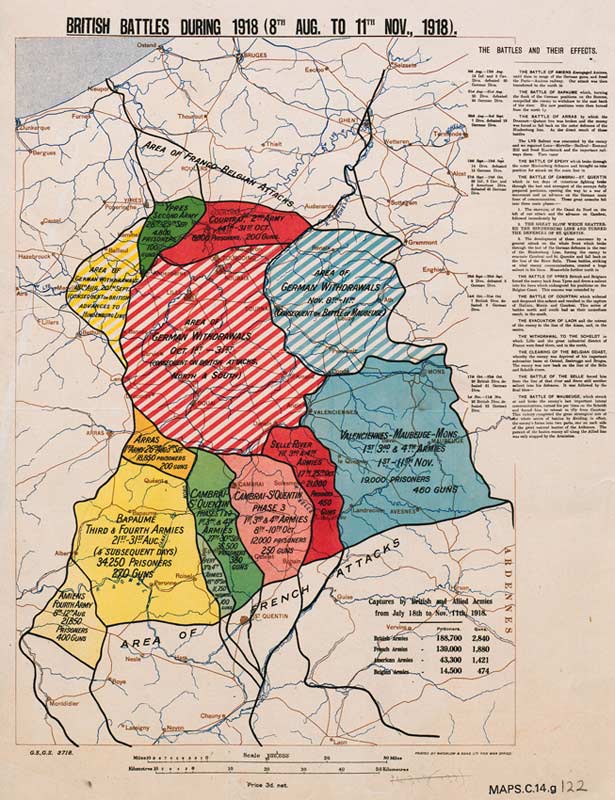
'THE GREAT WAR', 'THE WAR TO END WAR', 'WORLD WAR 1'
'What passing-bells for these who die as cattle?
- Only the monstrous anger of the guns.'
from 'Anthem for Doomed Youth'
by Wilfred Owen
1914 - 1918
BRITISH BATTLES DURING 1918 (8th AUG. TO 11th NOV., 1918)
This map (in the 'Public Domain') is viewable as a much larger image, with zoom capability, on the British Library website, HERE

This descriptive text comes from the British Library website: It shows the advance as distinctly ordered phases, coloured first yellow, then green, red and blue. Diagonal stripes in these same colours distinguish German withdrawals from retreats. Text descriptions and figures of prisoners captured by Allied forces are also supplied. The language of the map suggests an inevitability to German defeat in which even withdrawals (such as to the Hindenburg line in February 1917) were part of the Allied plan. The map contributed to the public's evaluation and official justification of the cost of four years of war." On the British Library website, HERE, this map (in the 'Public Domain') is viewable with zoom capability, |
Transcript of text : THE BATTLES AND THEIR EFFECTS: THE BATTLE OF AMIENS disengaged Amiens, until then in range of the German guns, and freed the Paris - Amiens railway. Our attack was then transferred to the north in THE BATTLE OF BAPAUME which, turning the flank of the German positions on the Somme, compelled the enemy to withdraw to the east bank of the river. His new position was then turned from the north by THE BATTLE OF ARRAS by which the Drocourt - Quéant line was broken and the enemy was forced to fall back on the outer defences of the Hindenburg Line. As the direct result of these battles. THE LYS SALIENT was evacuated by the enemy and we regained Lens - Merville - Bailleul - Kemmel Hill and freed Hazebrouck and the important railways there. Then came THE BATTLE OF EPEHY which broke through the outer Hindenburg defences and brought us into position for attack on the main line in THE BATTLE OF CAMBRAI - ST. QUENTIN which in ten days of victorious fighting broke through the last and strongest of the enemy's fully prepared positions, opening the way to a war of movement and an advance on the German main lines of communication. These great assaults fall into three main phases : - 1. The storming of the Canal du Nord on the left of our attack and the advance on Cambrai, followed immediately by 2. THE GREAT BLOW WHICH SHATTERED THE HINDENBURG LINE AND TURNED THE DEFENCES OF ST. QUENTIN. 3. The development of these successes by a general attack on the whole front which broke through the last of the German defences in the rear of the Hindenburg Line, forcing the enemy to evacuate Cambrai and St. Quentin and fall back on the line of the River Selle. These battles, striking at vital enemy communications, created a huge salient in his lines. Meanwhile further north in THE BATTLE OF YPRES British and Belgians forced the enemy back from Ypres and drove a salient into his lines which endangered his positions on the Belgian Coast. This success was extended by THE BATTLE OF COURTRAI which widened and deepened this salient and resulted in the capture of Halluin, Menin and Courtrai. This series of battles north and south had as their immediate result, in the south, THE EVACUATION OF LAON and the retreat of the enemy to the line of the Aisne, and, in the centre, THE WITHDRAWAL TO THE SCHELDT in which Lille and the great industrial district of France were freed there, and in the north, THE CLEARING OF THE BELGIAN COAST, whereby the enemy was deprived of his important submarine bases at Ostend, Zeebrugge and Bruges. The enemy was now now back on the line of the Selle and Scheldt rivers. THE BATTLE OF THE SELLE forced him from the line of that river and drove still another salient into his defences. It was followed by the final blow - THE BATTLE OF MAUBEUGE which struck at and broke the enemy's last important lateral communications, turned his positions on the Scheldt and forced him to to retreat rapidly from Courtrai. This victory was completed the great strategical aim of the whole series of battles by dividing, in effect, the enemy's forces into two parts, one on each side of the great natural barrier of the Ardennes. The pursuit of the beaten enemy all along the Allied line was only stopped by the Armistice.
|
RETURN to 'Mixed Bag' Menu Page